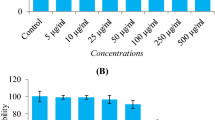Abstract
The present study was carried out to evaluate the in vitro cytoprotective effects of Psidium guajava and their isolated quercetin fraction to reduce the CCl4 (carbon tetrachloride) induced toxicity in HepG2 cell lines (Hepatocellular carcinoma G2). Silymarin was used as a standard drug to compare the protective effects of plant extracts in infected cell lines. MTT (3-[4,5-dimethylthiazol-2-yl]-2,5-diphenyl-tetrazolium bromide) assay, cell viability assay, leakage parameters [Aspartate aminotransferase (AST), Alanine aminotransferase (ALT) and Lactate dehydrogenase (LDH)], lipid peroxidation and reduced glutathione (GSH) levels were used to find out the protection of human derived HepG2 cells against CCl4-induced damage. The levels of cytotoxicity, viability and GSH were reduced. While the activities of AST, ALT, LDH and lipid peroxidation was increased in CCl4-treated groups. The treatment of P. guajava and their isolated quercetin fractions (100, 200, 300 µg/mL) decreased the elevated levels of all these parameters. The results of the present study suggest that the ethanolic extract of P. guajava leaf and their isolated quercetin fractions can able to reduce the CCl4-induced cytotoxicity in HepG2 cell lines.


Similar content being viewed by others
References
Valentin-Severin I, Le-Hegarat L, Lhuguenot JC, Le Bon AM, Chagnon MC. Use of HepG2 cell line for direct or indirect mutagens screening: comparative investigation between comet and micronucleus assays. Mutat Res Genet Toxicol Environ Mutagen. 2003;536(1):79–90.
Salvadori DM, Ribeiro LR, Natarajan AT. The anticlastogenicity of β-carotene evaluated on human hepatoma cells. Mutat Res Lett. 1993;303(4):151–6.
Krithika R, Verma RJ. Ameliorative potential of Phyllanthus amarus against carbon tetrachloride induced hepatotoxicity. Acta Pol Pharm. 2009;66(579):e83.
Gutiérrez RM, Mitchell S, Solis RV. Psidium guajava: a review of its traditional uses, phytochemistry and pharmacology. J Ethnopharmacol. 2008;117(1):1–27.
Morais-Braga MFB, Carneiro JNP, Machado AJT, Santos ATL, Sales DL, Lima LF, Figueredo FG, Coutinho HDM. Psidium guajava L., from ethnobiology to scientific evaluation: elucidating bioactivity against pathogenic microorganisms. J Ethnopharmacol. 2016;194:1140–52.
Tachakittirungrod S, Ikegami F, Okonogi S. Antioxidant active principles isolated from Psidium guajava grown in Thailand. Sci Pharm. 2007;75(4):179–93.
Ghosh R, Tiwary BK, Kumar A, Chakraborty R. Guava leaf extract inhibits quorum-sensing and Chromobacterium violaceum induced lysis of human hepatoma cells: whole transcriptome analysis reveals differential gene expression. PLoS ONE. 2014;9(9):e107703.
Vijayakumar K, Vijayaanand A. Protective effects of P. guajava and its isolated fraction on CCl4 induced oxidative stress. Res J Pharm Technol. 2016;9(8):1155–60.
Ahmadu AA, Hassan HS, Abubakar U, Akpulu IN. Flavonoid glycosides from Byrsocarpuscoccineus leaves. Schum and Thonn (Connaraceae). Afr J Tradit Complement Altern Med. 2007;4(3):257–60.
Harries HM, Fletcher ST, Duggan CM, Baker VA. The use of genomics technology to investigate gene expression changes in cultured human liver cells. Toxicol In Vitro. 2001;15(4):399–405.
Mosmann T. Rapid colorimetric assay for cellular growth and survival: application to proliferation and cytotoxicity assays. J Immunol Methods. 1983;65(1–2):55–63.
Darzynkiewicz Z, Li X, Gong J. Assays of cell viability: discrimination of cells dying by apoptosis. Methods Cell Biol. 1994;41:15–38.
Wu D, Cederbaum AI. Development and properties of HepG2 cells that constitutively express CYP2E1. In: Nagy LE, editor. Alcohol. Methods in molecular biology. Vol. 447. Totowa: Humana Press; 2008. p. 137–50.
Lowry OH, Rosebrough NJ, Farr AL, Randall RJ. Protein measurement with the Folin phenol reagent. J Biol Chem. 1951;193(1):265–75.
Vijayakumar K, Rengarajan RL, Radhakrishnan R, Vijaya Anand A. Hypolipidemic effect of Psidium guajava leaf extract against hepatotoxicity in rats. Pharmacogn Mag Biol Pharm Bull. 2018;14(53):1–8.
Banaee M, Sureda A, Mirvaghefi AR, Rafei GR. Effects of long-term silymarin oral supplementation on the blood biochemical profile of rainbow trout (Oncorhynchus mykiss). Fish Physiol Biochem. 2011;37(4):885–96.
El-Ahmady SH, Ashour ML, Wink M. Chemical composition and anti-inflammatory activity of the essential oils of Psidium guajava fruits and leaves. J Essent Oil Res. 2013;25(6):475–81.
Moon JY, Lee S, Jeong S, Kim JC, Ahn KS, Mosaddik A, Cho SK. Free radical-scavenging activities and cytoprotective effect of polyphenol-rich ethyl acetate fraction of guava (Psidium cattleianum) leaves on H2O2-treated HepG2 Cell. J Korean Soc Appl Biol Chem. 2013;56(6):687–94.
Liu CW, Wang YC, Hsieh CC, Lu HC, Chiang WD. Guava (Psidium guajava Linn.) leaf extract promotes glucose uptake and glycogen accumulation by modulating the insulin signaling pathway in high-glucose-induced insulin-resistant mouse FL83B cells. Process Biochem. 2015;50(7):1128–35.
Ibrahim TA, El-Hela AA, Abd_Elhady NM, Abo-Elfetoh NM. Phytochemical composition, in vitro antioxidant and cytotoxic activities of seeds of Convolvulus arvensis Linn. Int J Pharm Bio Sci. 2017;7(2):107–16.
Roy CK, Kamath JV, Asad M. Hepatoprotective activity of Psidium guajava Linn. Leaf extract. Indian J Exp Biol. 2006;44:305–11.
Shenoy KA, Somayaji SN, Bairy KL. Hepatoprotective effects of Ginkgo biloba against carbon tetrachloride induced hepatic injury in rats. Indian J Pharmacol. 2001;33(4):260–6.
Aniya Y, Koyama T, Miyagi C, Miyahira M, Inomata C, Kinoshita S, Ichiba T. Free radical scavenging and hepatoprotective actions of the medicinal herb, Crassocephalum crepidioides from the Okinawa Islands. Biol Pharm Bull. 2005;28(1):19–23.
Udem SC, Madubunyi II, Okoye JO, Anika SM. Anti-hepatotoxic effects of the ethanolic extracts of Combretum dolichopetalum root bark and Morinda lucida leaf. Fitoterapia. 1997;68(1):21–5.
Lee KW, Bode AM, Dong Z. Molecular targets of phytochemicals for cancer prevention. Nat Rev Cancer. 2011;11(3):211.
Russo M, Spagnuolo C, Tedesco I, Bilotto S, Russo GL. The flavonoid quercetin in disease prevention and therapy: facts and fancies. Biochem Pharmacol. 2012;83(1):6–15.
Anju V, Mary Zachariah S. Phytochemical screening, isolation, antibacterial and anticancer activity studies of Caesalpinia pulcherrima Linn. Leaves by HPTLC analysis. Int J Pharma Bio Sci. 2017;8(2):12–29.
Author information
Authors and Affiliations
Corresponding author
Ethics declarations
Conflict of interest
The authors declare no conflict of interest.
Rights and permissions
About this article
Cite this article
Vijayakumar, K., Rengarajan, R.L., Radhakrishnan, R. et al. Psidium guajava Leaf Extracts and Their Quercetin Protect HepG2 Cell Lines Against CCL4 Induced Cytotoxicity. Ind J Clin Biochem 34, 324–329 (2019). https://doi.org/10.1007/s12291-018-0752-z
Received:
Accepted:
Published:
Issue Date:
DOI: https://doi.org/10.1007/s12291-018-0752-z




